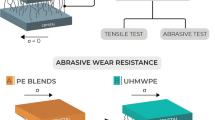Abstract
Based on the grey relational analysis, this work proposes an effective approach for optimizing various injection moulding parameters on the wear behaviours of ultra-high molecular weight polyethylene (UHMWPE) with diverse performance characteristics. The injection moulding parameters are melting temperature, injection velocity and compaction time. The experimental data were used to calculate wear parameters, such as coefficient of friction, wear rate and hardness. Thirty runs were carried out using the response surface design to determine the optimal factor level condition. The graph and the response table in each level of the parameters are generated with help of grey relational grade. In addition to that, bovine serum is taken, which acts as a lubricant, and the sample hardness is tested. The results showed that there is an impact on the wear behaviour due to the contact load and melt temperature of UHMWPE. According to the grey relational grade, level 2 of injection moulding parameters has a greater effect than levels 1 and 3. With the help of a scanning electron microscope, the worn-out morphologies of samples were studied. Plastic deformation, ploughing, scratching, ironing and fatigue wear are the major wear processes of our study.






Similar content being viewed by others
References
Patel N R and Gohil P 2012 Int. J. Emerg. Technol. Adv. Eng. 2 91
Thomas S, Grohens Y and Ninan N (eds) 2015 Biomaterials: design, development and biomedical applications (UK: William Andrew Publishing)
Nasab M B, Hassan M R and Sahari B B 2010 Trends Biomater. Artif. Organs. 24 69
Pajarinen J, Lin T H, Sato T, Yao Z and Goodman S B 2014 J. Mater. Chem. B 2 7094
Hutley T J and Ouederni M (eds) 2016 Polyolefin compounds and materials: fundamentals and industrial applications (Switzerland: Springer, Cham)
Owonubi S J, Agwuncha S C, Fasiku V O, Mukwevho E, Aderibigbe B A, Sadiku E R et al (eds) 2017 Polyolefin fibres (UK: Woodhead Publishing)
Mihalko W M, Haider H, Kurtz S, Marcolongo M and Urish K 2020 J. Orthop. Res. 38 1436
Brockett C L, Carbone S, Fisher J and Jennings L M 2017 Wear 374 86
Singh G, Klassen R, Howard J, Naudie D, Teeter M and Lanting B 2018 Hip Int. 28 573
Teo A J, Mishra A, Park I, Kim Y J, Park W T and Yoon Y J 2016 ACS Biomater. Sci. Eng. 2 454
Wu S L, Qiao J, Guan J, Chen H M, Wang T, Wang C et al 2023 Eur. Polym. J. 184 111799
Patel K, Chikkali S H and Sivaram S 2020 Prog. Polym. Sci. 109 101290
Gote R P, Romano D, van der Eem J, Zhao J, Zhou F and Rastogi S 2022 Macromolecules 56 361
Mecking S and Schnitte M 2020 Acc. Chem. Res. 53 2738
Zhang D, Nadres E T, Brookhart M and Daugulis O 2013 Organometallics 32 5136
Sánchez-Sánchez X, Hernández-Avila M, Elizalde L E, Martínez O, Ferrer I and Elías-Zuñiga A 2017 Mater. Des. 132 1
Kashyap S and Datta D 2015 Int. J. Plast. Technol. 19 1
Kuo H C and Jeng M C 2010 Mater. Des. 31 884
Ge S, Wang S and Huang X 2009 Wear 267 770
Lv H, Chen X, Wang X, Zeng X and Ma Y 2022 Int. J. Heat Mass Transf. 183 122159
Jorner K, Brinck T, Norrby P O and Buttar D 2021 Chem. Sci. 12 1163
Sarker I H 2021 SN Comput. Sci. 2 420
Gori Y, Verma R P, Patil P P and Taluja R 2021 Webology 18 3
Mukhametzyanov I 2021 Decis. Mak. Appl. Manag. Eng. 4 76
Wang G, Zhao B, Wu B, Zhang C and Liu W 2023 Int. J. Min. Sci. Technol. 33 47
Fu J, Zhang Y, Wang Y, Zhang H, Liu J, Tang J et al 2022 Nat. Protoc. 17 129
Yang Y K 2006 Polym. Plast. Technol. Eng. 45 769
Yang Y K, Shie J R and Huang C H 2006 Mater. Manuf. Process. 21 832
Tretinnikov O N, Ogata S and Ikada Y 1998 Polymer 39 6115
Xue Y, Wu W, Jacobs O and Schädel B 2006 Polym. Test. 25 221
Unal H and Mimaroglu A 2003 Mater. Des. 24 183
Jeng M C, Fung C P and Li T C 2002 Wear 252 934
Chand N, Dwivedi U K and Sharma M K 2007 Wear 262 184
Acknowledgements
We would like to thank Mr N Basheer Ahamed, Managing Partner, M/s Metro consulting, Chennai, India, for his critical suggestions. The help rendered by Prof Dr C Muralidharan and Dr C Senthil Kumar (Assistant Professor), Mr N Raja, A Raja Narayanan, R Raj (UG Students) and Mr A Balaguru, Department of Manufacturing Engineering, Annamalai University, Mr R Madura, MR Engineering, Ekkatuthangal, Chennai, in the conduct of the experiments, is also acknowledged.
Author information
Authors and Affiliations
Corresponding author
Rights and permissions
Springer Nature or its licensor (e.g. a society or other partner) holds exclusive rights to this article under a publishing agreement with the author(s) or other rightsholder(s); author self-archiving of the accepted manuscript version of this article is solely governed by the terms of such publishing agreement and applicable law.
About this article
Cite this article
Mohamad Raffi, N., Vijayanand, M. & Sivamani, S. Optimization of injection moulding parameters on wear properties of ultra-high molecular weight polyethylene. Bull Mater Sci 47, 56 (2024). https://doi.org/10.1007/s12034-023-03116-w
Received:
Accepted:
Published:
DOI: https://doi.org/10.1007/s12034-023-03116-w




